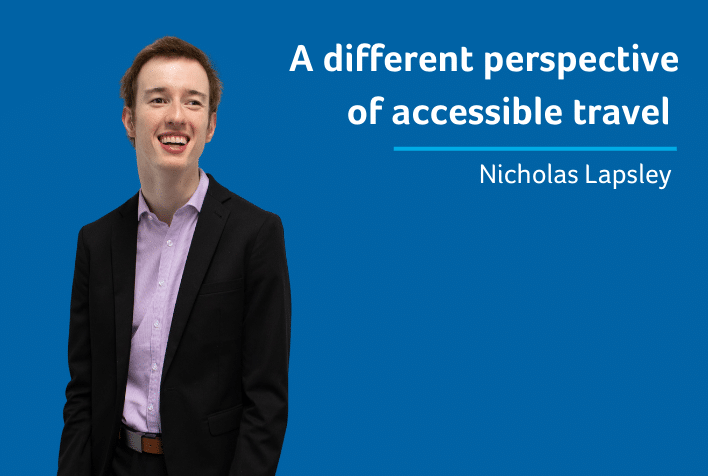
So, what is accessible travel? You may think it’s just about accessibility requirements for people in wheelchairs and other mobility aids. But it is so much more than this, we need to think more broadly and inclusively as there are so many people living with disabilities who don’t necessarily use a wheelchair. In fact, disabilities are not always visible.
Let’s look at it from my perspective. I have mild ataxic cerebral palsy and I don’t use a wheelchair as I can walk quite a fair distance without any issues. I do need to sit occasionally, to rest my leg. I also have two hearing aids that allow me to hear other people talking, but I still sometimes have issues hearing people in noisy places.
Airports can be very noisy when busy due to a lot of hard surface material that bounces noise off; for example, windows and hard floors. Soft furnishings like plants and carpets can help absorb sounds to make it less noisy. I am often asking people to repeat themselves or to write it down so I can understand what they are saying. Also, if the airport has a terrible layout, sometimes going through security can take forever which makes my legs quite tired.
I will be travelling internationally again soon, which is exciting, so I will experience what it’s like to travel through an international airport after the COVID lockdown and restrictions to see if there are any changes to airports.
For accommodation I don’t need an accessible room, I just need to make sure the room has a few features to help me have a smooth stay. I always make sure I don’t book a room with a combination of bath and shower; this is for safety reasons as I tend to need to hold onto something to keep myself stable. I can climb up stairs easily, but I do like them to have railings along the stairs so that I have something to hold on to.
When it comes to attractions and places to visit, I look for the same accessibility requirements as airports and accommodations. The main two things I’m mindful of are the noise level at the place and how many stairs there are. I have been to a temple in Hong Kong where I had to climb up a lot of stairs and I felt exhausted once I reached the top. For these types of adventures, I need to consider them on the day in relation to how I am feeling.
This is a brief overview of what accessible travel looks like for me as someone with mild ataxic cerebral palsy. We have seen many great inclusion improvements over the years for everyone who has a disability. This includes
The sunflower lanyard was started for those who don’t have a visible disability. Tamsin Colley is a regular user of this lanyard and she said
For me, travel can be very overstimulating due to my Autistic sensory issues, so I usually try to avoid it. However, when I do need to travel there are some things that can help such as wearing headphones, and wearing a Sunflower Lanyard that signals to people that you may need a little extra time or assistance due to a hidden disability.
Tamsin Colley
Everyone is different, and you should always be open to adapt so you can make people with disabilities travel journey smoother and more enjoyable. We still have a lot of room for improvement to be made in the travel space, but it is slowly getting better.
Bio
Nicholas Lapsley is a 22-year-old aspiring entrepreneur and disability advocate. He works for Cerebral Palsy Alliance’s Marketing & Communications team and is an active member of CPActive, where he campaigns for equality for people with cerebral palsy and other disabilities. He is also the host of the Accessible Travel Podcast.